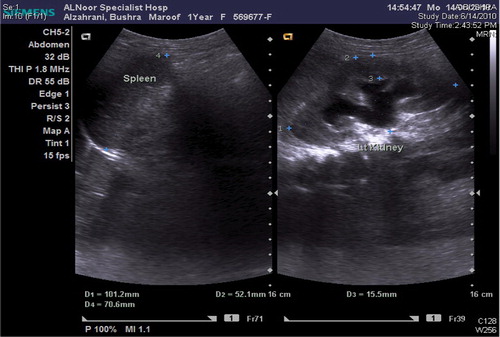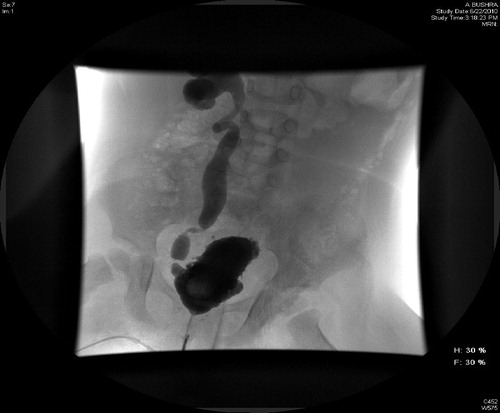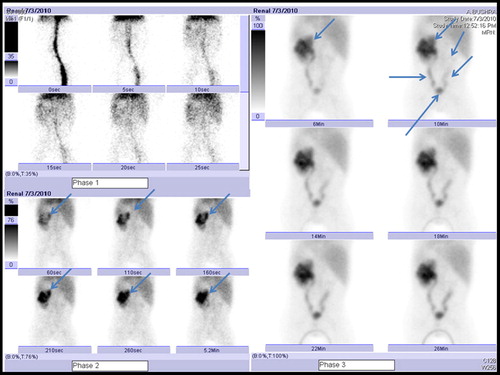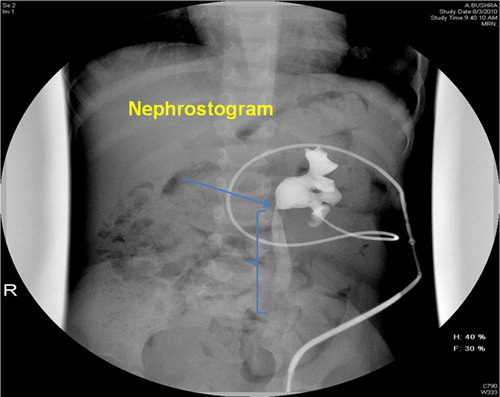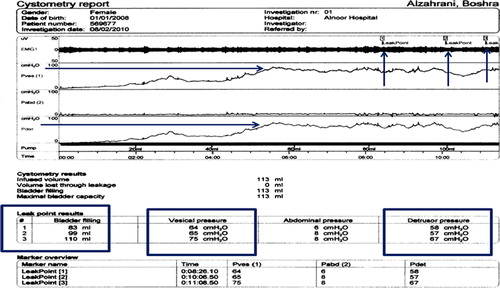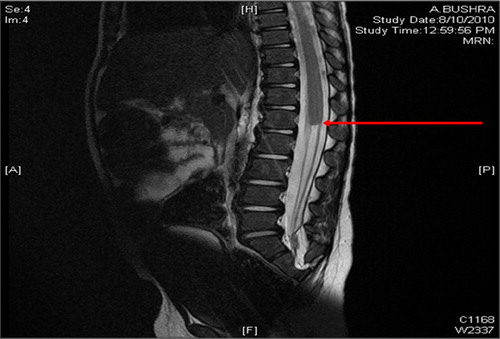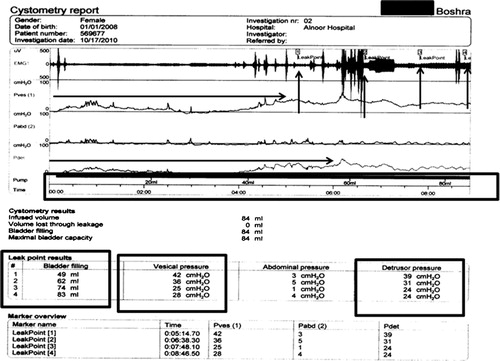1 Introduction
Caudal Regression Syndrome (CRS) is also known as ‘Sacral Agenesis’ which represents vertebral anomaly and imperfections in the caudal region. It is a congenital syndrome; therefore, abnormalities in the fetal development are serious outcomes of this condition. Impaired development in the caudal region will affect the general health status of the patients.Citation1 This syndrome usually occurs in combination with morphologic dysfunction of the feet and spinal cord malformations. It can be said that CRS is a rare and serious medical condition, which should be addressed properly.Citation2 Vertebral column bone malformations, bones of feet and legs, the pelvic bone, absent genitalia, blocked opening of the anus, and ureters fused are some of the symptoms of CRS.Citation1
Urinary tract infection is a very common medical condition, which mostly occurs in hospitals or clinical settings ‘nosocomial infection’.Citation3 Difficulty in urination and impaired functioning of the bladder are two extremely common symptoms of urinary tract infection. A proper treatment approach is required by the professionals to eliminate the condition of UTI (Urinary Tract Infection) effectively.Citation4
Neurogenic bladder is another very common condition, in which an individual lacks the control of bladder because of deformities within the spinal cord, brain, or nervous supply. A number of nerves and muscles mostly work together for the attainment of specified function. A very common example regarding the bladder is, urinary incontenince. In this condition, the brain is unable to control the functions of bladder, which results in neurogenic bladder.Citation5 These three medical conditions have similar signs, symptoms, and nature, which frequently result in poor diagnosis.
2 Methodology
2.1 Study design
This research has used case study design for deriving out the specified outcomes, which is very commonly used and have an association with rare medical condition. In case of very small sample size, the approach of case study is used for the identification of hidden factors. The incidence rate of CRS is extremely rare condition, which occurs in 1 child among the population of 25,000 individualsCitation6; therefore, it would become very hard for the investigators to make a healthy sample size.Citation7 For this purpose, case study approach has been used for this research project.
The findings obtained from the case study strategy can be applied on similar cases of the selected medical condition. Additionally, the approach of case study will derive out effective outcomes by various means. A number of relative literatures are mostly used in the research project for making positive relevance to the existing knowledge.Citation8
2.2 Case presentation
The case study, which was selected for this research project, is related to a 2 years old girl, a citizen of Saudi Arabia. She got admitted in at Alnoor specialist hospital, department of pediatrics, with the complaints of fever, diarrhea, and vomiting. The parents of the patient clearly indicated that she had these three symptoms for 3 days With further history taking, they mentioned that vomiting was a frequent symptom; and the patient used to vomit (non-bilious) for about 5–6 times per day.
Additionally, the parents further added that diarrhea was also frequent; occurring 4–5 times a day, the nature of diarrhea was not watery. The urination process was also described as painful with intense frequency and urgency. Offensive smell of the urine was also observed during investigation. The patient was also facing suprapubic pain during admission. The oral intake of the patient was decreased along with the activities of the patient.
The past history of the patient evidently mentioned that the patient has been admitted in different hospitals for three times. The 1st admission in the hospital was due to urinary tract infection. The second was regarding right feet abscess. However, bacterial meningitis was the third reason for hospital admission at the age of 2. The mother of the patient was suffering from Diabetes Mellitus during pregnancy. The mother has normal antenatal and postnatal history. The child and mother were vaccinated as per recommended Saudi vaccination schedule. Family history of the patient revealed that the parents are third degree relatives.
The physical examination of the patient also revealed various factors in relation with the possible condition of Caudal Regression Syndrome. The physical examination showed that the patient was febrile and lethargic. The patient had urosepsis which suggests abnormal bladder function which can be possibly present especially with infant of diabetic mother. The temperature of the patient was 40 °C, which was affecting her general health status. The pulse rate was 129 per minute, respiratory rate was 40 per minute, and blood pressure was 120/80 mmHg. The neurological examination of the patient did not show any abnormality.
2.3 Approach used for findings
Different types of approaches have been used for the proper configuration of the findings. Blood tests, urine tests, radiologic evaluations, renal nuclear study, cystoscopy, urodynamics, and magnetic resonance imaging were used for investigating the health status of the patient.
3 Results
3.1 Investigation of patient
A proper investigation was carried out with the help of different tools to derive effective outcomes.
Complete blood count was done as seen in . The urine culture and sensitivity test has shown the presence of klebsiella pneumonia. The presence of blood was not found in the urine after using culture and sensitivity (C&S) test. Negative HIV Elisa and normal level of immunoglobulin serum was identified in immunology evaluation test.
Table 1 CBC results.
3.2 Radiology evaluation
Another very important approach, which was used for investigation, is radiology evaluation. It is mentioned above that CRS is the abnormal development or absence of the vertebras or caudal bone in the lower region of back. For proper investigation, the use of radiology approaches will certainly result in the identification of unseen factors.
For constructive movement of the study, ultrasound of the kidney was done after B.’s parents consent. – clearly indicate the major and minor findings of ultrasound. The ultrasound of the right kidney demonstrated that the size of the kidney was normal and average. The right kidney had thin parenchyma with marked hydronephrosis and a dilated ureter has been identified by the ultrasound. Additionally, ultrasound of left kidney is showing certain enlargement in the structure. The parenchyma of left kidney is 1.5 cm; however, moderate hydronephrosis and dilated ureter have been observed. The ultrasound has further presented partially filled urinary bladder. All of the findings clearly demonstrated abnormalities in the structures and functions of the renal system.
Voiding cysto-urethro-gram was another approach used for the investigation, as seen in and . The comprehensive findings of VCUG have shown drastic outcomes. Decreased capacity of the bladder with serrated and irregular outline has been observed. The V-U reflux of right side is of grade IV; however, reflux of left side is of grade I. Trabeculated bladder wall with bilateral V-U reflux was identified. Also, the possibility of a neurogenic bladder.
3.3 Renal nuclear study
The renal nuclear study was another approach; is representing the findings of renal nuclear study with the help of DTPA. The findings have shown non-functioning right kidney; however, the functions of left kidney were moderate with delayed and slow excretion.
3.4 Cystoscopy
The approach of cystoscopy was used after treating pyelonephritis. The report has shown patent both vesicouretic with bilateral vesicouretic reflux. Moreover, obstructive secondary PUJ has been observed in the report. The cystoscopy report is illustrated in .
3.5 Urodynamics
Bladder functions were assessed by urodynamics, as seen in . Increased intra-vesicle pressure was observed with the bladder volume of 83 ml. This condition is responsible for causing increased intra-vesicle and detrouser pressure. The pressure of intra-vesicle and detrouser are 64 and 58 mmH2O respectively.
3.6 Magnetic resonance imaging (MRI)
demonstrates the MRI report of the lumbar spine; MRI have shown partial sacral agenesis; however, only S1 and S2 sacral bones are present. Furthermore, abrupt termination of Conus Medullaris has been identified at the level of L1. These findings are clearly indicating the presence of Caudal Regression Syndrome.
3.7 Repeated urodynamics
After two months urodynamics were re-assessed again after the use of Oxybutynin and the treatment of pyelonephritis and prophylaxis. The treatment was covered with the help of anticholinergics and antibiotics. The results showed improvement in bladder capacity, as illustrated in .
4 Discussion
Two years old B., had recurrent admissions secondary to recurrent sepsis. The most common possibility of the sepsis is urosepsis. The findings clearly indicate the presence of neurogenic bladder secondary to sacral agenesis and CRS. Both conditions have a relationship with the diabetic mother.
Caudal Regression Syndrome refers to the impaired development or absence of caudal bone. The presentation of this condition usually varies from absence of coccygeal segments to agenesis of lumbosacral region. This is a rare medical condition, which occurs in 1 child among the population of 25,000 individuals.Citation6 The risk of mortality is extremely low. Different evidence based literatures have shown that most of the patients are at the risk of various co-morbidities after getting indulged with this syndrome. Various bladder-related disorders can be developed in an individual, coping with the condition of Caudal Regression Syndrome.Citation9 The male to female ratio of CRS is 2.7:1.Citation10
Third degree familial marriages refers to the distribution of gene and genetic materials, which are shared by two blood family members. One eight of the genes have been shared by third degree relatives. Prior studies show that a number of acute, chronic, and serious medical conditions can occur as a result of marriage between third degree relatives.Citation11 The mother of the patient is 20 years old, and she was on insulin treatment at the time of pregnancy. The father of the patient was 29 years old, who suffers from bronchial asthma. B. is the only child in the family. There was no history of miscarriage or still birth regarding this family.
The etiology of CRS has indicated that the diabetic state of the mother will increase the risk of this syndrome. Moreover, premature pregnancy and ischemic events will also enhance the risk of CRS. Presence of infection or substance toxicity of mother during pregnancy will also make a negative impact over the health of fetus.Citation12
It is extremely important to know about the relationship between diabetes mellitus and Caudal Regression Syndrome. It has been evaluated that the condition of hyperglycemia will make a negative impact over DNA function & structure.Citation13 Furthermore, increased blood glucose level will also increase the level of oxidative stress and also lead to hyperketonemia. All increased values can increase the risks of defects and malformations of the fetus.Citation14
All the defects are strongly associated with the lower half of the human body and Similarly, will also affect the structures and processes of genitourinary system. Studies have observed dysmorphogenesis in relation with embryonic metanephrosis. This finding is also dependent upon the increased levels & concentrations of the glucose in blood.Citation15
Proper understanding of the pathogenesis is of importance for making a proper diagnosis. It has been evaluated by various studies that disruption in the maturation of caudal region will lead an individual towards neurologic impairment. The condition of neurologic impairment will directly affect the genitourinary system; neurological loss such as incontinence of urine is a common symptom of neurological impairment.Citation16 Various and different medical conditions of musculoskeletal system, central nervous system, cardiac systems, gastrointestinal system, respiratory system, and genito-urinary system are directly associated with CRS. Co-morbidities have a serious impact over the general physical and mental health status of the patients.Citation17
There are certain disorders, problems and issues which are strongly connected with CRS. Absence of tail bone partially is the leading problem, and is strongly connected with the condition of CRS. It is a fact that impaired development of the spinal cord may result in the partial absence of the tail bone and relative regions. At the same time, extreme malformations are usually observed at the level of pelvis, vertebrae, and spine. Malformations will affect the general functioning of the systems and organs of the human body. It is also seen that in some cases the symptoms are not fully present to show the minor problems, hence the patient comes with no complaint.Citation18 Birth defects, neurological impairment and urine incontinence are very common problems and directly associated with the condition of CRS. Studies have also shown that flaccid paralysis of the lower extremities may also occur as a result of Caudal Regression Syndrome.Citation19
Presence of the associated problems independently will also increase the risk of CRS. Urinary tract infection is considered as a serious medical condition, which has the capability to increase the risk of CRS. The urine test of the patient showed the presence of klebsiella pneumonia; a pathogen that has the capability to cause urinary tract infection. It has been evaluated that the factor of urinary tract infection will increase the risk of neurogenic bladder.Citation20 Neurogenic bladder is a serious medical problem, in which an individual lacks the control of bladder. This medical issue will affect the normal functioning of genito-urinary system. Bladder voiding and painful urination are common symptoms of neurogenic bladder.Citation21
The condition of neurogenic bladder is a very common symptom of CRS. Therefore, urinary tract infection is a very general differential diagnosis of Caudal Regression Syndrome. The health care professionals and clinicians should give excessive concentration to evaluate the correct medical conditions with the help of different tools. Therefore, it is said that neurogenic bladder and CRS will cause similar symptoms and conditions.Citation22
A study was conducted by Moritoki et al. (2013), has shown that CRS has the ability to cause neuropathic bladder without producing any neurogenic symptoms. It has been evaluated by the study that CRS is a vertebral anomaly, which will affect the morphologic dysfunction and malformations of the lower region of spinal cord. The study mentioned that this syndrome will result in the renal dysfunction because of its symptoms. The patient will become extremely prominent to the symptoms of impaired renal functions, impaired bladder functioning, and painful urination. By the time, the patient will also lose control of the bladder in relation with the urination.Citation23 Therefore, the condition of neurogenic bladder will occur.
The study has mentioned that the condition of CRS usually do not produce any major or minor symptoms in the patient, therefore, the diagnosis is discovered after a while. To avoid this condition, it is extremely necessary for the health care professionals to use radiological approaches. It is a fact that neurological manifestations usually correspond with the vertebral agenesis. Therefore, the patient will not suffer from any neurological defect. Urodynamics testing is the leading diagnostic approach, which has shown that the impaired urinary tract function is directly associated with CRS. Therefore, the study clearly mentioned that Caudal Regression Syndrome, urinary tract infection, and neuropathic bladder are closely attached with each other.Citation23
Another study was conducted by Semba and Ki (2013), which was focused on the different causes of CRS. The study has shown that Caudal Regression Syndrome is a rare medical condition, which will affect the caudal region of the fetus during development. The study has mentioned that increased glucose level of the mother will affect the normal development of the fetus. Our study has also shown that the state of hyperglycemia is the leading reason for the occurrence of CRS.Citation24
Although it was priorly mentioned that increase blood glucose has a negative impact on DNA. However, our study showed diabetes mellitus is not the main cause of CRS. Presence of infection is another very common cause of this medical condition. The urine test has shown presence of Klebsiella pneumoniae in the patient.Citation24 Soria et al. (2011) has also supported the influence of infection and toxicity over the CRS. The study further mentioned that partial or complete absence of tail bone will emerge various complications in an individual. The findings of this study and the outcomes of past studies are similar and authentic. It is a fact that the patient has been hospitalized due to the condition of UTI. The presence of urinary tract infection directly affected the normal functioning of bladder and genito-urinary system.Citation25 It has now become clear that the patient is suffering from the condition of CRS and neurogenic bladder presented by urinary tract infection.
Sacral agenesis is another very common differential diagnosis, which refers to the complete or partial absence of the tail bone. A study has shown that the condition of diabetes mellitus and genetic deformity will increase the risk of sacral agenesis. The study mentioned that genetic factors will play a hazardous role in the development of caudal region.Citation26 Another study has shown that mutation in HLXB9, a homeodomain gene, will increase the risk of sacral agenesis.Citation27 Similarly, another study has also supported this statement that mutation of the HLXB9 is responsible for the occurrence of sacral agenesis.Citation28 A study has also shown that urinary continence can be easily attained with the help of long term treatment approaches.Citation29
5 Conclusion
Caudal Regression Syndrome is a rare congenital medical condition, in which an individual suffers from impaired development of the tail bone in the caudal region. Urinary tract infection is a very common type of nosocomial infection, which affects the urinary tract. Neurogenic bladder is another very common problem, in which an individual lacks the control of his bladder. It is seen that CRS, neurogenic bladder and UTI infections have analogous signs and symptoms, which usually results in the poor or confused diagnosis. Clinical history, physical examination, blood tests, urine tests, radiologic evaluations, renal nuclear study, cystoscopy, urodynamics, and magnetic resonance imaging are common approach, which can be used for effective diagnosis. Diabetic mother will increase the chances of CRS. Therefore, it can be said that caudal regression syndrome and neurogenic bladder can be presented as urinary tract infection.
Conflict of interest
No conflict of interest and contending financial benefits have been declared by the research workers in regards with this project.
Acknowledgements
I am significantly grateful to Almighty God who granted me potential, strength, and fortitude to conduct this research rightfully. Then, I am thankful to my colleagues, who assisted me during the complicated aspects of this study and the junior doctors shared in the follow up of this patient. And to Dr. Mograbi, our pediatric urologist, for his help in proceeding with the study. I expect that this analysis will strengthen my motivation, and will encourage me during prospect tasks.
Notes
Peer review under responsibility of Alexandria University Faculty of Medicine.
References
- Z.KokrdovaCaudal Regression SyndromeJ Obstet Gynaecol332013202203 Retrieved fromhttp://informahealthcare.com/doi/pdf/10.3109/01443615.2012.743508
- P.SharmaS.KumarA.JaiswalClinico-radiologic findings in group II Caudal Regression SyndromeJ Clinical Imaging Sci20133 Retrieved fromhttp://www.ncbi.nlm.nih.gov/pmc/articles/PMC3779398/
- T.M.HootonUncomplicated urinary tract infectionN Engl J Med366201210281037 Retrieved fromhttp://tmedweb.tulane.edu/portal/files/open-access/Clerkships/internal-medicine/Ambulatory/Uncomplicated_UTI.pdf
- B.FoxmanThe epidemiology of urinary tract infectionNature Rev Urology72010653660 Retrieved fromhttp://www.nature.com/nrurol/journal/v7/n12/full/nrurol.2010.190.html
- A.KanaiI.ZabbarovaY.IkedaSophisticated models and methods for studying neurogenic bladder dysfunctionNeurourol Urodyn302011658667 Retrieved fromhttp://onlinelibrary.wiley.com/doi/10.1002/nau.21120/full
- A.Sendhil CoumaryV.C.SunithaJ.S.Vasavi KolluruCaudal Regression Syndrome: a rare case reportInt J22014344 Retrieved fromhttp://www.ejmanager.com/mnstemps/93/93-1380435096.pdf?t=1401423067
- Yin RK. Case study methods. 2012. Retrieved from http://psycnet.apa.org/books/13620/009.
- G.EastonCritical realism in case study researchInd Market Manage392010118128 Retrieved fromhttp://www.mega-project.eu/assets/exp/resources/critical_realism_-_easton.pdf
- O.TemizkanF.AbikeH.AyvacıA.YılmazE.Demiragl.SanverdiPrenatal diagnosed Caudal Regression SyndromeOpen J f Obstet Gynecol32013227 Retrieved fromhttp://www.scirp.org/journal/PaperDownload.aspx?PaperID=28656
- B.KnightCaudal Regression Syndrome: a caseReport2011281282 Retrieved fromhttp://www.aana.com/newsandjournal/documents/caudal_0811_p281-282.pdf
- L.AlmasyT.D.DyerJ.M.PeraltaData for genetic analysis workshop 18: human whole genome sequence, blood pressure, and simulated phenotypes in extended pedigreesBMC Proc82014S2 Retrieved fromhttp://www.biomedcentral.com/1753-6561/8/S1/S2/
- S.BegumR.ShelimT.BegumN.NaharCaudal Regression Syndrome – a case report and literature reviewJ Bangladesh College Phys Surg292011166169 Retrieved fromhttp://www.banglajol.info/bd/index.php/JBCPS/article/download/9439/6996
- I.BicakciS.T.TurgutB.TurgutA.IcagasiogluZ.EgilmezY.YumusakhuyluA case of Caudal Regression Syndrome: walking or sitting?Pan Afr Med J182014 Retrieved fromhttp://www.panafrican-med-journal.com/content/article/18/92/full/
- A.C.Polanco PonceM.C.Revilla MonsalveM.A.Palomino GaribayS.Islas AndradeEffect of maternal diabetes on human and rat fetal developmentGinecol Obstet Mex732005544552 Retrieved fromhttp://www.ncbi.nlm.nih.gov/pubmed/16583835
- S.S.ChughE.I.WallnerY.S.KanwarRenal development in high-glucose ambience and diabetic embryopathySemin Nephrol232003583592 Retrieved fromhttp://www.ncbi.nlm.nih.gov/pubmed/14631566
- J.J.WyndaeleA.KovindhaH.MadersbacherNeurologic urinary incontinenceNeurourol Urodyn29201059164 Retrieved fromhttp://onlinelibrary.wiley.com/doi/10.1002/nau.20852/full
- Hutson JM. Multiple malformation syndromes in DSD. In: Disorders of sex development. Springer Berlin Heidelberg; 2012:97–101 Retrieved from http://link.springer.com/chapter/10.1007/978-3-642-22964-0_10.
- I.GenneroS.Laurencin-DalicieuxF.Conte-AuriolAbsence of the lysophosphatidic acid receptor LPA1 results in abnormal bone development and decreased bone massBone492011395403 Retrieved fromhttp://www.ncbi.nlm.nih.gov/pmc/articles/PMC3697734/
- T.PennimpedeJ.ProskeKonigIn vivo knockdown of Brachyury results in skeletal defects and urorectal malformations resembling Caudal Regression SyndromeDev Biol37220125567 Retrieved fromhttp://www.sciencedirect.com/science/article/pii/S0012160612005076
- M.GacciL.VignozziA.SebastianelliMetabolic syndrome and lower urinary tract symptoms: the role of inflammationProstate Cancer Prostatic Dis162012101106 Retrieved fromhttp://www.nature.com/pcan/journal/v16/n1/full/pcan201244a.html
- P.SharmaS.KumarA.JaiswalClinico-radiologic findings in group II Caudal Regression SyndromeJ Clinical Imaging Sci20133 Retrieved fromhttp://www.ncbi.nlm.nih.gov/pmc/articles/PMC3779398/
- E.CerchiaA.L.BulottaM.RuscelliR.AngottiG.Di MaggioM.MessinaSplit-appendix technique: surgical choice for complete incontinence in Caudal Regression SyndromeJ Siena Acad Sci520139397 Retrieved fromhttp://transmedreports.org/index.php/jsas/article/download/jsas.2013.93/3360
- Y.MoritokiY.KojimaH.KamisawaK.MizunoK.KohriY.HayashiNeuropathic bladder caused by Caudal Regression Syndrome without any other neurogenic symptomsCase Rep. Med.2012 Retrieved fromhttp://www.hindawi.com/journals/crim/aip/982418/
- K.SembaY.KiEtiology of Caudal Regression SyndromeHuman Genet Embryol32013 2161-0436, Retrieved fromhttp://omicsonline.org/etiology-of-caudal-regression-syndrome-2161-0436.1000107.pdf
- A.SoriaJ.IglesiasG.Villagomez MartinezP09. 15: Caudal Regression Syndrome: a case reportUltrasound Obstet Gynecol382011 203-203, Retrieved fromhttp://onlinelibrary.wiley.com/doi/10.1002/uog.9739/pdf
- C.PapapetrouF.DrummondW.ReardonR.WinterL.SpitzY.H.EdwardsA genetic study of the human T gene and its exclusion as a major candidate gene for sacral agenesis with anorectal atresiaJ Med Genet361999208213 Retrieved fromhttp://www.ncbi.nlm.nih.gov/pmc/articles/PMC1734318/pdf/v036p00208.pdf
- A.J.RossV.Ruiz-PerezY.WangA homeobox gene, HLXB9, is the major locus for dominantly inherited sacral agenesisNat Genet201998358361 Retrieved fromhttp://www.nature.com/ng/journal/v20/n4/full/ng1298_358.html
- J.KochlingM.KarbasiyanA.ReisSpectrum of mutations and genotype-phenotype analysis in Currarino syndromeEur J Hum Genet92001599605 Retrieved fromhttp://www.ncbi.nlm.nih.gov/pubmed/11528505
- JorgensenL.H.OlsenT.M.JorgensenLong-term follow-up in spinal dysraphism: Outcome of renal function and urinary and faecal continenceScand J Urol Nephrol4420109510010.3109/00365590903494916 Retrieved from


